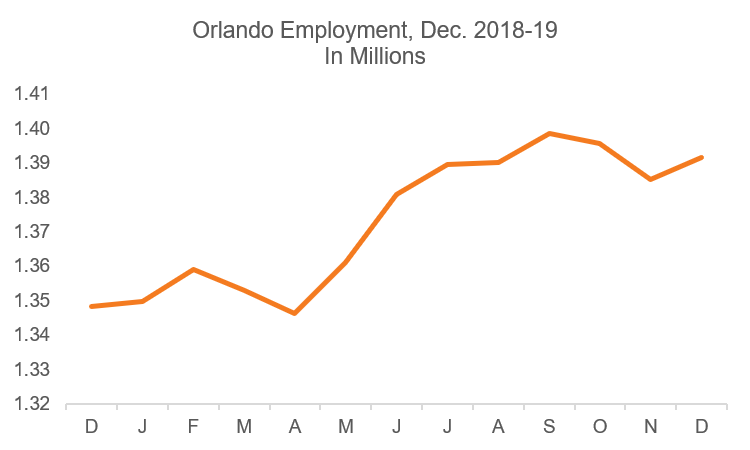Orlando is among the fastest-growing job markets in the U.S.

Data emerging from the final quarter of 2019 shows that Orlando is the third fastest growing job market in the U.S. and the fastest in Florida, adding 43,300 jobs in 2019. The fourth quarter of 2019 also marked the launch of the Orlando Prosperity Scorecard, a regional dashboard of 11 indicators aimed at measuring Orlando’s advancement towards broad-based prosperity. Job growth, an integral part of the scorecard, is only one component to building a strong economy.
The following update wraps up coverage of 2019’s largest economic news stories, provides a glimpse into 2020 and outlines the next series of Orlando economic updates; where job growth is considered alongside other metrics such as third grade reading proficiency and the number of extremely cost burdened households as measures of economic success.
Wrapping Up 2019
2019 began with heightened fears of a recession as an inverted yield curve and global manufacturing slowdowns signaled a coming recession. However, by quarter three, those fears had quieted as a strong labor market and continued gross domestic product (GDP) gains carried on – despite predictions that the U.S. economy was on the verge of a downturn.
The Federal Reserve
This year’s spotlight was reserved for the Federal Reserve (the Fed). A year ago, the Fed was signaling several rate hikes throughout 2019. However, the Federal Open Market Commission took an unusual monetary policy U-turn, cutting U.S. interest rates in three successive meetings starting in July, lowering the Federal Funds Rate to what is now 1.55 percent. At the end of its final policy meeting in Washington this year, the Fed voted unanimously to leave its benchmark rate in a range of 1.5 percent and 1.75 percent, indicating no hikes for at least another year.
The Yield Curve
The inverted yield curve received heavy media coverage in 2019 and contributed to headlines signaling a pending recession. See an explanation of the yield curve here. Recently, however, the yield curve un-inverted; a result of Fed’s intervention via overnight repurchase agreements or repos. The Fed’s money-market operations are aimed at ensuring the financial system has enough liquidity, pumping money through the system to stabilize short term interest rates.
The U.S. Labor Market
The U.S. job market ended 2019 out of tune, with December’s payroll and wage growth falling short of expectations. After a strong 256,000 gain in payrolls in November, the labor department recorded that December nonfarm payrolls increased by a disappointing 145,000, missing economist’s expectations of 160,000.
2019 was not a pleasant year for manufacturing jobs. Manufacturing activity in the U.S. continued to drag, mostly attributed to the U.S. and China trade battle. The Institute for Supply Management reports that the manufacturing index fell in December to 47.2, marking its lowest levels since June 2009. It also marked the fifth straight month of contractions in the manufacturing index.
Gross Domestic Product Growth
U.S. gross domestic product (GDP) increased at an annual rate of 2.1 percent in the third quarter of 2019 according to data released by the Bureau of Economic Analysis (BEA). This is up from the second quarter increase of two percent.
Growth in consumer spending, which accounts for more than two-thirds of U.S. economic activity, contributed the most to GDP growth, with spending on goods (durable and non) increasing at a 5.3 percent rate for quarter three. Meanwhile private investment decreased 1.0 percent overall.
2020 Outlook
After a dramatic year that marked economic and political uncertainty, the U.S. economy is entering 2020 with a pace of steady but decelerated growth according to the Atlanta Fed GDPNow forecast. The latest model estimates real GDP growth in the fourth quarter of 2019 to be 1.8 percent. This slowdown is due to further contraction in business investment and eroding business confidence as a result of the Trump administration’s trade war.
However, things are shaping up in recent weeks. The passage of a new trade agreement with Mexico and Canada, and the signing of “Phase One” trade deal with China signals the current economic expansion is likely to continue into 2020. Driven primarily by better trade conditions and enabling monetary policy, the tight economic conditions of early 2019 have reversed. This exhibits a growth impulse that will likely accelerate to 2.5 percent in 2020.
Regional Spotlight: Measuring Broad-Based Prosperity in 2020
Still the fastest growing job market in the State, the Orlando economy created 43,300 jobs in 2019. Manufacturing and construction continued to be the fastest growing industries in the region, growing by 6.4 and 7.1 percent respectively. While 43,300 is more jobs created than 2018’s count of 41,800, Orlando did not continue to be the fastest growing job market in the country. Austin and Dallas grew at a rate of 3.5 and 3.4 percent, putting Orlando in a close third place with a growth rate of 3.3 percent.

In 2020, expect a new series of economic updates that dive into the Orlando Prosperity Scorecard and explore a framework of opportunities, access, and capabilities. The Central Florida region is projected to add 1,500 people each week to the population through 2030 and creating jobs for those new residents is a key component to building a more prosperous future. Just as important is talent development, housing and transportation to ensure that new residents have the capabilities and access to take advantage of the opportunities created by the Orlando economy.
Job growth and GDP growth are not the only components worthy of signaling economic advancement. While the number of jobs in the region has been increasing, so has the number of struggling households. More than 45 percent of Orlando’s household’s live paycheck to paycheck, or worse; earning wages that put families and struggling singles into an income bracket below ALICE thresholds. The number of struggling households is rarely presented alongside GRP in economic updates or projections.

Regional rankings and events of note that took place during the fourth quarter of 2019 include:
- Low-fare carrier Frontier Airlines announced recent approval by the Greater Orlando Aviation Authority of its plans to build a 35,000-square-foot hangar at Orlando International Airport (MCO). Alongside its new 11,000-square-foot flight attendant recurrent training center, Frontier’s $10 million maintenance hangar will include indoor parking for Frontier’s largest aircraft, the Airbus A321, and an outdoor auxiliary pad for two additional Airbus A320-family aircraft.
- Electronic Arts announced the construction of a new $62 million, 180,000-square-foot, five- story building in the heart of downtown Orlando, bring its more than 700 employees to the 68-acre digital media district called Creative Village.
- Solai & Cameron Technologies along with its subsidiary, Novatio Solutions, a software company that focuses on the Artificial Intelligence (AI) and Robotic Process Automation (RPA) industry, announced the relocation of its headquarters and training center operations from Chicago to the City of Orlando, creating 200 new projected high-wage jobs for the region.
- Orange County Mayor Jerry Demings alongside Universal Parks executives announced the initiative to increase affordable housing near Universal Orlando Resort. The 20-acre project is expected to accommodate nearly 1,000 mixed-use housing units.
Article co-written by:

Moutasm Badawi Research
Current student at the University of Central Florida pursuing a Bachelors of Science in Economics with minors in PreLaw and Business Analytics as well as a Burnett Honors College student attaining undergraduate research in the field of economics.





